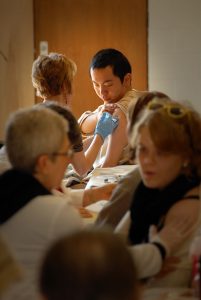 Pandemic and seasonal influenza viruses represent an important threat to public health. Vaccination is the primary and most effective strategy for protection against influenza. Currently, most influenza vaccines are manufactured using embryonic chicken eggs, but the viral vaccine in eggs has a lag-time of 6 months between the identification and isolation of the strain and the market availability of the final product. Such lead-time, and the dependence of the process on the availability of eggs, hinders the ability to quickly respond to pandemics.
Pandemic and seasonal influenza viruses represent an important threat to public health. Vaccination is the primary and most effective strategy for protection against influenza. Currently, most influenza vaccines are manufactured using embryonic chicken eggs, but the viral vaccine in eggs has a lag-time of 6 months between the identification and isolation of the strain and the market availability of the final product. Such lead-time, and the dependence of the process on the availability of eggs, hinders the ability to quickly respond to pandemics.
This is motivating the shift towards a cell culture based manufacturing process that is rapidly scalable, less labor intensive, and characterized by a shorter lead-time. While advancements in the upstream processing of vaccine manufacture have been significant, there has not been a corresponding progress in the downstream product vaccine isolation and purification approaches.
Led by Dr. Stefano Menegatti and Dr. Amith Naik, this initiative seeks to develop a truly continuous downstream process enabled by low-cost disposable non-woven membranes and silica resins. Their proposed downstream process for virus vaccines based on completely flow-through approach and synthetic ligands will offer a new paradigm to aid the rapid and low cost manufacture of vaccines. The PIs have begun their work with several experiments towards the preliminary characterization of the cell lysate, from which to purify the target vaccine and will be using Institute support to engage a post-doctoral scholar to accelerate their research activities in fiscal year 2016-17.
This project is also supported by the NC State Department of Chemical and Biomolecular Engineering and BTEC and will seek additional support through the NSF, NCBC, Novartis, Merck, and the Gates Foundation. The PIs plan to collaborate and host a Kenan Fellow in the second year of the project.
